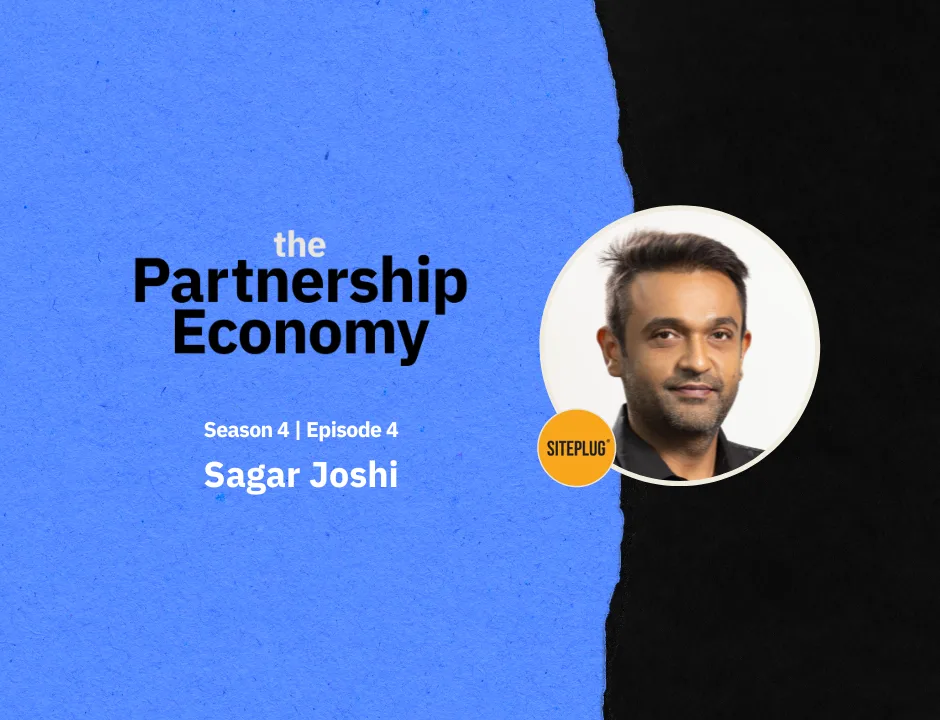Join host Todd Crawford as he sits down with Sagar Joshi, Director of Partnerships at Site Plug. Site Plug is a bottom-of-the-funnel performance partner that helps brands drive performance with touch bases across a variety of search engines and websites. He’s spent seven years in this role, and learned about the industry across a variety of locations including Europe and India. They discuss unique channels in the content marketing space, the importance of leveraging alternative search engines and improved transparency for brands on where their ads are appearing. This podcast episode was produced by Quill.
Canned Intro [00:00:01] Welcome to The Partnership Economy. This podcast explores the power of partnerships through candid conversations with industry leaders. Join our host, Dave Yovanno, CEO and Todd Crawford, co-founder of Impact.com as they unpack the future of partnership as a lever for scale and an opportunity to put the consumer first.
Todd Crawford [00:00:24] Welcome to The Partnership Economy podcast. I’m your host, Todd Crawford. And today we’ve got an exciting conversation with Sagar Joshi, focusing on the role alternate search engines can play in the affiliate space. For the past seven years, Sagar has been the director of partnerships at SitePlug. SitePlug is a bottom of the funnel performance partner that helps brands drive sales through touchpoints across a variety of search engines and content websites. Sagar has spent time learning about the industry from different regions, including France, India and the US. Outside of SitePlug and Affinity, Sagar can be found cycling passion that’s brought him 10,000 miles across the US, Europe and India. Today, we’ll explore the benefits of how to get in front of consumers to alternate search engines, as well as how brands can expand their reach beyond the North America and European markets. If you’re looking to tap into these larger markets but unsure how this episode will shed light on how you can get started. I hope you enjoy. Sagar, welcome to the podcast. It’s great to have you on. Well, I’m really excited for this episode because I think a lot of people are aware of SitePlug, but maybe they don’t know as much as they should. And we’re going to clear that all up today.
Sagar Joshi [00:01:44] Thank you, Todd, for giving me this opportunity. Glad to be here.
Todd Crawford [00:01:49] Probably the first thing to start with is SitePlug and Affinity and the other business unit. So if you could maybe just explain the lay of the land. I think Affinity is the owner and then you have all these sub business units and Siteplug is one. But if you could give us the whole and then we’ll dig in to the to the piece of site plug.
Sagar Joshi [00:02:07] Affinity Global Inc. is the holding company that actually is headquartered out of Chicago. We have offices all over the globe and currently Affinity is a very fast growing privacy friendly adtech company. We deliver innovative cross funnel consumer engagement products for both advertisers and publishers. To give you a quick [00:02:30]gist about our suite of products. Basically what we include within Affinity is for ad networks and two publisher facing SaaS platforms. The ad network portfolio includes mCanvas for top funnel branding, VEVE for mid funnel performance across OEMs and browser placements and of course Siteplug. This network is designed for the bottom funnel catering to performance driven campaigns. And Siteplug today covers a spectrum of placements, including coupons, content, email type of domains, innovative search placements, ensuring and optimize approach to achieving results. We also have two SaaS products, as I mentioned. The first one is AdOpsOne, which is an AI powered ad operations assistant for publishers using Google Ad Manager. And we recently launched Nucleus, which is an automation platform for commerce and affiliate publishers. Today, Affinity has 400 employees across India, U.S., UK, Europe, Indonesia, China, Malaysia, Brazil and I’d just like to finish it off with we’ve just recently acquired our first company, Opinary, which is a German based consumer engagement technology company. So now we also have 30 employees in Germany, in Berlin too, which is our seven business unit.
Todd Crawford [00:03:56] Wow. That’s a lot, a lot going on there. But we’re going to focus more on SitePlug because even as you describe that, there’s a lot within SitePplug. And I think that’s where people not so much get confused. They’ve just uninformed about all the things that site can do. Before we jump in there, Sagar, I want to learn a little bit about you and what got you into the performance marketing space. Can you just give us a little bit of your background and your journey to Affinity?
Sagar Joshi [00:04:23] Yeah, so I had a little bit of experience in the ad tech industry. I started my career when I was just right out of college and joined a leading ad tech house that got acquired by company years down the line. But let’s back up to 2016. This is when Affinity was looking for someone to come and build a team from scratch. As I mentioned, I had some experience at my previous stint, only this time I wanted to repeat the process with some more control, ownership and freedom at the same time. So yeah, I joined seven years ago. We had a few innovative formats within Siteplug that had never been offered or tested in the affiliate space. This pretty much blocked our entry when the affiliate and partnership ecosystem and of course eventually with the support and platforms such as Impact.com it just accelerated adoption to reach out or to partner with some of the top companies in the US. We opened doors and explored hallways of the so-called affiliates and partnership ecosystem.
Todd Crawford [00:05:24] Awesome. Yeah. No, it’s exciting. And as you mentioned, when you describe SitePlug as being in the portfolio of the other companies more focused at bottom funnel, which obviously is really a good fit in the affiliate space or the performance marketing space. And I almost quite you redescribe what a SitePlug does because there was a lot there and you go into some of this in more detail, but maybe just describe again the touch points or the marketing placements that you make available to brands.
Sagar Joshi [00:05:58] Sure. So SitePlug today heads brands get access to placements on content websites, coupon websites, email clients, just basically creating new touchpoints across different formats, across different real estate. We identify these unique touchpoints and we scaled such traffic and performance to make sure we’re driving the best [00:06:18] ROAS and the best ROI for brands spending with us. So just imagine SitePlug as a bottom funnel marketing performance partner that drive sales from unique placements across some very unique real estate.
Todd Crawford [00:06:32] Yeah. And the other touch point you mentioned is I guess search. And when you say search, most people think Google, but you guys bring the rest of the search opportunities to bear that most companies just don’t prioritize as part of their search strategy because they just go for where the most searches are. And you guys, I think of it round out a brand search strategy. And I’d love for you to walk us through what that really is.
Sagar Joshi [00:07:02] Yes. So I think today SitePlug, what it’s doing, it’s bringing search engines in light of today’s opportunities and basically bringing different search engines in the affiliate space. Siteplug identifies these search engines, which are not your mainstream search engines. And what we go and tell them is we’re going to help you monetize your search queries in a more effective way. So we obviously have different search engines coming up and signing up with us and we make sure that we are delivering privacy friendly and really innovative formats to the advertisers and agencies that want budgets or want to be placed on these alternative search engines. As you mentioned, there is a lot of action happening outside the likes of Google or Bing, today that are search engines like DuckDuckGo. We have a search engine called Ecosia. Today, we are nurturing all these different search engines to come and we had them monetize their traffic.
Todd Crawford [00:07:58] So, how does it work when you start to talk with a brand and you get involved with them through their affiliate program? What are the typical things that you’re going to help them understand and the placements that you’re going to work with on that?
Sagar Joshi [00:08:15] So usually when we target a brand, we do have a lot of information on what kind of relevant traffic is available for this brand. We have so many internal tools and then we work so much more closely with our partners that we are able to derive these metrics that give us very accurate placement of a media brands. Today, a brand, for example, has no restrictions or wants to go all out with insight to being placed on every format that includes search engines, content, coupons. We distribute these affiliate links across all our network of publishers to identify the new users and how well they’re engaging with the so-called brand.
Todd Crawford [00:08:57] What are some of the distinct placement opportunities? Where else are these placements available outside of [00:09:05]maybe some of these, I would say not lesser known search engines. I think DuckDuckGo is a very well known search engine to some. Not everyone uses it, but the people that do, that’s their search engine. So you want to get in front of them. But then there’s other types of placements that are unique that I think most brands in their marketing team really don’t have a strategy around, right?
Sagar Joshi [00:09:28] Yeah, Todd. That’s absolutely correct. Today, I think in the last two years we introduced a couple of unique formats, particularly ads within Yahoo Mail. Yahoo is one of our direct channel partners and Yahoo uses SitePlug as one of their vendors to help them monetize their real estate. Similarly, we’re doing it for Microsoft Outlook as well. These are two unique e-mail channels that we have brought in the affiliate space. Prior to this, nobody was having an idea of what these kind of formats are doing in the affiliate space. So, yes, we brought them, we onboarded them. We provided brands with unique placements across these email clients. We gave them the transparency [00:10:10]as well, so today brands are able to see where the ads are appearing, what users are clicking, they getting to know what the user and when the user’s transacting. Apart from the alternate search engines that I just spoke about, we have also onboarded Yahoo as partners. So we also had Yahoo search engine to monetize their real estate as well. Not all the inventory is available to a brand marketer on Yahoo Search. There are other vendors providing some plug-ins and some placements across Yahoo and the Yahoo! Content properties as well.
Todd Crawford [00:10:45] So when you guys have at SitePlug offers from brands that are performing well, I’m just curious, did the other business units get informed? Do you guys have a way, a mechanism to like work with the other business units inside an Affinity?
Sagar Joshi [00:11:03] That’s a great question, Todd. To be honest, that happens a lot. We obviously have seven business units within and we each share contacts. If it’s a strategic fit or if it’s a perfect fit in terms of ownership or even a publisher provider. So today we are shedding are basically a relationship that we have onboarded to other business units within Affinity as well, provided they’re a good fit. But today again, Affinity, the business units are designed in a way that Siteplug and VEVE, they are more popular in the western part of the world, as well as the branding, the mCanvas and all are more [00:11:37] APAC and Asia centric.
Todd Crawford [00:11:39] I think obviously Asia is a big market and I think not just intra Asia business, which is obviously a big business for you, but are you seeing more North American or even European brands wanting to get into the Asian markets? How is that trend been?
Sagar Joshi [00:11:57] Yes, a lot of them, as as I mentioned today, a part of our business helps OEMs monetize. So the original equipment manufacturers, the Samsungs and the Xiaomi and the phone manufacturers today, they have our formats sold in their own browsers. So today any brand that is looking for reach beyond the North America’s or [00:12:17]beyond the Europes, beyond the likes of the other, we give them these placements. And as you mentioned, Asia is a phenomenal market, especially if you want to reach millions of consumers and we’re a very Android heavy market today. The penetration over Android devices in this part of the world in Asia is extremely high. So yesterday, brands that are offering global products or shipping, so on and so forth, they want to be featured on these OEMs as well.
Todd Crawford [00:12:47] We’ve been seeing the same thing and we also see a lot of companies that are historically coming out of Asia focused solely on Europe or the US market. So out of China, they’re called China out brands, right? Like they’re really not focused on selling into the Chinese market. They’re trying to sell into the US market. So obviously that’s huge for them and they’re basically acting like a US brand would, right, even though they’re maybe headquartered or shipping from Asia. And I think the US market trying to get into the Asian market, I think there’s been a lot of progress on just the cost of shipping or logistics around that, because that’s probably what’s held up a lot of the penetration there is just the increased costs to getting a product out of the US. Right. So that’s pretty important, I think, for brands to realize that the appetite is there, that middle class, the rise of the middle class in Asia has been huge and they’re hungry for European and North American products and services.
Sagar Joshi [00:13:53] Absolutely. Just to give you a quick perspective, the US has about 200, 250 million mobile phones sold close to the population. Just to give you an idea. India today stands at about, I think about 600 or 700 million mobile devices. So that’s to be extra bucket. And as you mentioned, the middle class, we have one of the widest pieces of middle class and the income that is being earned. A lot of it is going on buying products online or buying products from the US and getting it shipped to India or China or different parts of Asia. The world is going more global as we speak.
Todd Crawford [00:14:28] Yeah, and you mentioned that the penetration of Android in mobile phones, even just in India, how huge that is. And what is also interesting is that is there a single device to access the Internet in a lot of these emerging countries. They don’t have like in US and Europe, where personally I have my work laptop, I have my own laptop, I have an iPad and iPhone, and I could be shopping on any of those four devices at any time. In these emerging markets, the power of a mobile phone now is so great that they don’t even see a need to invest in anything beyond that. That is really their access point. So I think for brands trying to go into those markets being cognizant that this is a not necessarily a mobile app play, but a mobile experience and most likely an Android mobile experience is important.
Sagar Joshi [00:15:23] Yeah, that’s absolutely correct. Well said. As you mentioned today, many people in Asia, there’s only one device they’re transacting using. And also to highlight the fact that today India and some parts of Asia have the cheapest data plans. They can consume thousands of GB at the cost of maybe half of what you’re paying for your monthly bill. It’s astonishing the way the telecoms have adapted to the consumer, keeping consumers in mind. And of course, being Asia being India will always very price conscious in certain things and Internet is one of them as well.
Todd Crawford [00:15:54] Yeah, and that opens up more and more consumers. Right. So making it easy to be online or less expensive to be online. And the Android phones, obviously, there’s tons of different types of Android phones and you can get them for a lower price than an iPhone, which is the alternative. It does create a huge consumer base. And again, this rise of the middle class is really driving a lot of that as well. And the prestige of having a phone, it used to be something more exclusive. But today when you go to Asia, there’s nobody without a phone. It’s just, that it’s so prevalent. And and I think it’s only going to get stronger and stronger. So for especially Western brands, this is the frontier that I think everybody’s trying to penetrate and get marketshare there because it’s so huge and it’s only getting bigger. So I guess just to wrap up, what’s got you excited in this industry right now? What have you been thinking about or working on or or just even just excited about when it comes to the affiliate or performance marketing industry?
Sagar Joshi [00:17:05] I think what excites me is the constant evolution of the consumer. Today we live in a post-pandemic world. Things have changed in the way we think and we talk and transact. So just writing that board over the last three to four years has been a tremendous experience. Brands are trying to cut down on budgets, considering we just went through a pandemic and even interesting search by dance today, the likes of people are not searching on devices are not searching on Google before. They’re searching on devices such as TikTok and different search engines or Facebook or Amazon, for that matter. Just seeing and writing this whole wave currently and seeing this shift currently happening is tremendous and really excited to see the next few years of where we end up.
Todd Crawford [00:17:53] You know, that’s what keeps me excited as well. A constant evolution, iteration and innovation in this space. The publishers, like you guys, are constantly changing the opportunities and expanding and creating new opportunities or just making opportunities that exist far more easy to get into and scale, which I think is a big thing that SitePlug has been doing. For a brand to do everything that SitePlug could do in-house would be a lot of time and effort that might not produce the return on ad spend that SitePlug can because you’ve figured so much stuff out and you’ve got the processes and the tech behind it to make it super fast and easy to scale.
Sagar Joshi [00:18:38] Yeah, absolutely. We just over the years we’ve been constantly educating all our partners about our offerings, what our unique offerings and everything’s outside the traditional media offerings. So today, at the end of the day is SitePlug user that has made a is about a product. Eventually that user has costed much less for the brand as compared to Google or Facebook or any of the other likes. So we really try on the fact that we are efficient, we performance driven and basically we want to do a lot more. It just never stops.
Todd Crawford [00:19:11] I wish you guys continued success and I hope all of our listeners have learned a lot more about SitePlug. I know I have, and I think like I said, you guys have so much that you’re able to do that I think there is a little bit of a knowledge gap and I hope that we’ve helped to close that today. And if people are interested in reaching out to you, I know you guys operate within the networks as an affiliate account so they could find you in the networks, but they can also go to SitePlug.com and reach out to you guys there. Is that are those are the two best ways?
Sagar Joshi [00:19:41] Yeah, I think those will be the two best ways. On our website we have [00:19:45]sales distro which is sales@SitePlug.com and of course we are there at every affiliate trade show and event and conference that takes place and but of course and on LinkedIn as well. We’re pretty much very active on LinkedIn so definitely hit us up or goes up on LinkedIn to get a conversation going and we’d love to talk more.
Todd Crawford [00:20:02] Awesome. So I really appreciate you coming on the show today and sharing with us your thoughts on the Asian market as well as what SitePlugs up to.
Sagar Joshi [00:20:12] Thank you. Thank you, Todd. Thank you for having me.
Todd Crawford [00:20:16] Multiple brands are competing for consumer attention every day. In an effort to level the playing field, some brands are looking for alternate ways to get in front of the consumer, and oftentimes this looks like taking routes that might seem unconventional, like investing in placements outside of Google and Bing. Google and Bing or household names, consumers still have the power to learn about brands through alternate places like TikTok, YouTube, or within services like Yahoo Mail, which opens the door to new consumers. It’s key for brands to adopt a comprehensive strategy to lean on search engines outside of Google, combat the competition, especially when they return on ad spend on these alternate search engines can be generally higher. The opportunity to reach new consumers also exists in markets outside of North America and Europe. Sagar mentioned that there is a rise of middle class consumers in Asia today who are eager to discover brands and use their income to purchase global products predominantly from the US. It’s great to have Sagar on the show. Thanks for listening and I look forward to next time.
Canned Intro [00:21:22] Thanks for listening to the partnership economy brought to you by Impact.com. If you enjoyed today’s episode, be sure to subscribe to the show and rate and review it on Apple Podcasts.



